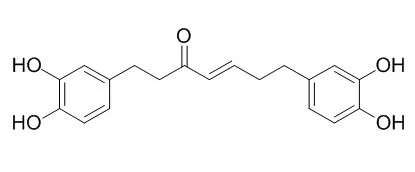| In vitro: |
| J Biol Chem. 2014 Jan 17;289(3):1723-31. | | The diarylheptanoid hirsutenone sensitizes chemoresistant ovarian cancer cells to cisplatin via modulation of apoptosis-inducing factor and X-linked inhibitor of apoptosis.[Pubmed: 24247248] | Cisplatin (CDDP) and its derivatives are considered first-line treatments for ovarian cancer (OVCA). However, despite initial results that often appear promising, in most cases patients will return with recurrent disease that fails to respond to further chemotherapy.
METHODS AND RESULTS:
We assayed a number of food phytochemicals with reported PI3K inhibitory ability to identify candidates that can influence CDDP treatment outcomes in chemoresistant OVCA cell lines.
A direct comparison revealed that the diarylheptanoid Hirsutenone from the tree bark of Alnus hirsuta var. sibirica was superior at inducing CDDP sensitivity in a number of chemoresistant cancer cell lines. Whereas Hirsutenone treatment activated p53, its modest efficacy in p53-mutant and -null cell lines suggested the existence of a p53-independent mode of action. Further investigation revealed that Hirsutenone causes CDDP-dependent apoptosis in chemoresistant cells by ubiquitin-proteasome-dependent X-linked inhibitor of apoptosis degradation and by enhancing the translocation of apoptosis-inducing factor from the mitochondria to the nucleus. This was found to be, at least in part, under the influence of upstream Akt activity, linking Hirsutenone-dependent PI3K inhibition with downstream effects on apoptosis-inducing factor, X-linked inhibitor of apoptosis, and apoptosis.
CONCLUSIONS:
Our findings provide rationale for further investigation of the effects of Hirsutenone on chemoresistant OVCA in clinical studies. | | Int Immunopharmacol. 2010 Apr;10(4):520-5. | | Hirsutenone inhibits lipopolysaccharide-activated NF-kappaB-induced inflammatory mediator production by suppressing Toll-like receptor 4 and ERK activation.[Pubmed: 20138154] | Adipogenesis is a key driver of the expansion of adipose tissue mass that causes obesity. Hirsutenone (HST) is an active botanical diarylheptanoid present in Alnus species. In this study, we evaluated the effects of HST on adipogenesis, its mechanisms of action and the molecular targets involved.
METHODS AND RESULTS:
Using Oil Red O staining, we observed that HST dose-dependently suppresses lipid accumulation during adipogenesis in 3T3-L1 preadipocytes, concomitant with a decrease in peroxisome proliferator-activated receptor-γ (PPARγ), CCAAT/enhancer-binding protein α (C/EBPα) and fatty acid synthase (FAS) protein expression. This inhibitory effect was largely limited to the early stage of adipogenesis, which includes mitotic clonal expansion (MCE), as evidenced by delayed cell cycle entry of preadipocytes from G1 to S phase. Furthermore, the regulation of MCE was accompanied by suppression of phosphatidylinositol 3-kinase (PI3K) and extracellular-regulated kinase (ERK) activity. HST was also shown to bind directly to PI3K and ERK1 in a non-ATP competitive manner.
CONCLUSIONS:
Our results suggest that HST attenuates adipogenesis by directly targeting PI3K and ERK during MCE in 3T3-L1 preadipocytes, underscoring the potential therapeutic application of HST in preventing obesity. | | Arch Pharm Res. 2008 Oct;31(10):1287-9. | | Cytotoxic activities of diarylheptanoids from Alnus japonica.[Pubmed: 18958419 ] |
METHODS AND RESULTS:
The diarylheptanoids (1-10) 1,7-bis-(3,4-dihydroxyphenyl)-heptane-3-O-beta-D-glucopyranosyl(1-->3)-beta-D-xylopyranoside (1), 1,7-bis-(3,4-dihydroxyphenyl)-heptane-3-O-beta-D-apiofuranosyl(1-->6)-beta-D-glucopyranoside (2), 1,7-bis-(3,4-dihydroxyphenyl)-heptane-5-O-beta-D-glucopyranoside (3), 1,7-bis-(3,4-dihydroxyphenyl)-5-hydroxyheptane (4), 1,7-bis-(3,4-dihydroxyphenyl)-heptane-3-one-5-O-beta-D-glucopyranoside (5), oregonin (6), hirsutanonol (7), Hirsutenone (8), 1,7-bis-(3,4-dihydroxyphenyl)-5-hydroxyheptane-3-O-beta-D-xylopyranoside (9), and platyphylloside (10), isolated from the bark of Alnus japonica, were analyzed for their cytotoxic activities on various human and mouse cancer cell lines. The cytotoxic activities of these ten compounds were evaluated against murine B16 melanoma, human SNU-1 gastric cancer, human SNU-354 hepatoma cancer and human SNU-C4 colorectal cell lines.
CONCLUSIONS:
The diarylheptanoids showed potent cytotoxic activities against murine B16 melanoma cells and human SNU-C1 gastric cancer cell when the cell viability was analyzed by MTT (3-(4,5-dimethylthiazol-2-yl)-2,5-diphenyltetrazoliumbromide) assay. |
|






 Cell. 2018 Jan 11;172(1-2):249-261.e12. doi: 10.1016/j.cell.2017.12.019.IF=36.216(2019)
Cell. 2018 Jan 11;172(1-2):249-261.e12. doi: 10.1016/j.cell.2017.12.019.IF=36.216(2019) Cell Metab. 2020 Mar 3;31(3):534-548.e5. doi: 10.1016/j.cmet.2020.01.002.IF=22.415(2019)
Cell Metab. 2020 Mar 3;31(3):534-548.e5. doi: 10.1016/j.cmet.2020.01.002.IF=22.415(2019) Mol Cell. 2017 Nov 16;68(4):673-685.e6. doi: 10.1016/j.molcel.2017.10.022.IF=14.548(2019)
Mol Cell. 2017 Nov 16;68(4):673-685.e6. doi: 10.1016/j.molcel.2017.10.022.IF=14.548(2019)